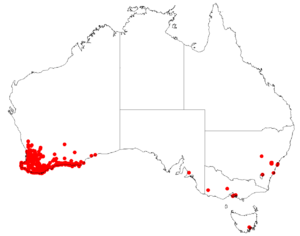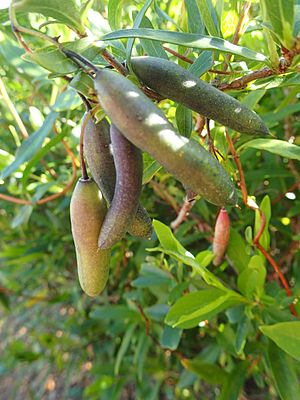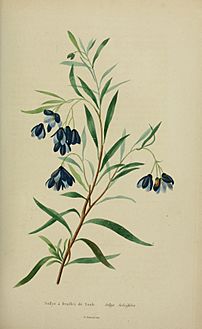Billardiera fusiformis facts for kids
Quick facts for kids Billardiera fusiformis |
|
|---|---|
 |
|
| Scientific classification | |
| Genus: |
Billardiera
|
| Species: |
fusiformis
|
 |
|
| Occurrence data from AVH | |
Billardiera fusiformis, also known as the Australian bluebell, is a beautiful flowering plant. It belongs to the Pittosporaceae family. This plant is native to the south-west part of Western Australia.
It grows as a strong, shrubby climbing plant. The Australian bluebell has long, narrow leaves. Its flowers can be blue, white, or pink. They usually hang downwards and grow alone or in small groups.
What it Looks Like
The Australian bluebell is a tough climbing plant. Its new stems are green and hairy. As they get older, they turn reddish-brown.
Its adult leaves are long and narrow, like a line or a thin oval. They are about 2.5 to 5 centimetres (1 to 2 inches) long. They are also about 2 to 6 millimetres (0.08 to 0.24 inches) wide. The leaves attach directly to the stem without a stalk. Both sides of the leaves are soft and hairy when new. They become smooth as they get older.
The flowers grow alone or in groups of up to four. Each flower hangs down on a small stalk, about 6 to 10 millimetres (0.24 to 0.39 inches) long. The sepals, which are like small leaves protecting the flower bud, are silky and hairy. They are about 2 to 3 millimetres (0.08 to 0.12 inches) long. These sepals fall off as the flower opens.
The petals of the flower can be blue, white, or pink. They are about 5 to 11 millimetres (0.2 to 0.43 inches) long and about 3 millimetres (0.12 inches) wide. The petals are separate from each other. This plant flowers in late spring and summer.
After flowering, the plant produces a fruit. It is a green, spindle-shaped berry. This means it is swollen in the middle and tapers at both ends. The fruit is about 20 to 25 millimetres (0.79 to 0.98 inches) long. It turns purplish as it gets older.
You can tell Billardiera fusiformis apart from other similar plants by its narrow leaves. Also, its blue, white, or pink petals are separate. The parts of the flower that hold pollen are also special.
How it Got its Name
The plant Billardiera fusiformis was first described in 1805. A French botanist named Jacques Labillardière gave it its name. He wrote about it in his book Novae Hollandiae Plantarum Specimen. He found specimens in a place he called "Van Diemen's Land."
The name fusiformis comes from Latin. It means "shaped like a spindle." This refers to the fruit of the plant, which is wider in the middle and tapers at the ends.
The genus name, Billardiera, honours Jacques-Julien Houtou de Labillardière. He was the first person to describe many Australian plants.
Where it Grows
The Australian bluebell is originally from the south-west of Western Australia. It grows in areas near the coast. It also grows in mallee heathlands. These are areas with small, tough shrubs.
This plant has been grown in gardens in other parts of Australia. Because of this, it has started to grow naturally in other states. These include Victoria, South Australia, Tasmania, New South Wales, and the Australian Capital Territory.
Weed Status
Even though it's a pretty garden plant, Billardiera fusiformis can sometimes become a problem. It has become a significant weed in several Australian states.
It can spread into woodlands, forests, and grasslands. When it grows too much, it can cover and smother smaller plants and shrubs. After fires, many new seedlings can grow in areas where it is already present.
Small native animals like potoroos, quokkas, and bush rats help spread its seeds. They eat the fruits, and the seeds can grow better after passing through their digestive system.
Images for kids





